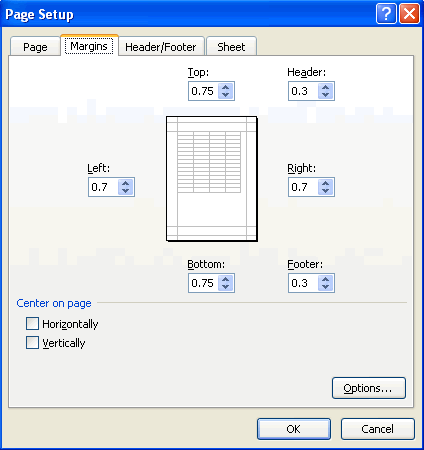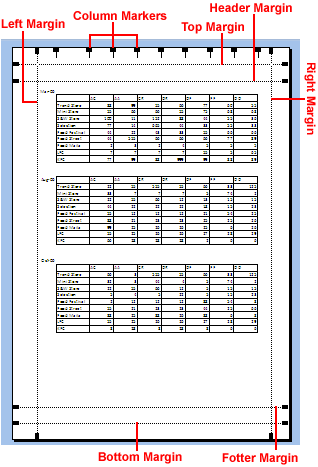Set Page Margins
Margins are the blank spaces that border a printed page (top, bottom, left, and right). The wider the margins, the less space that is available for printing. You can control all four page margins from Excel.
Choose Page Layout> Page Setup> Margins. A list of margin options. Select from the margins options shown or choose Custom Margins to open the Page Setup dialog box that enables you to set your own margin options and then click ok.

The default worksheet margins are the Normal settings, which are .75 inch on both the top and bottom and .70 inch on the left and right sides and 0.30 inch on the header & footer. Select one or both Center on Page options in the Margins tab of the Page Setup dialog box to center a selection of data (that takes up less than a full page) between the current margin settings. In the Center on the Page section, select the Horizontally check box to center the data between the left and right margins. Select the Vertically check box to center the data between the top and bottom margins.
In addition to the Normal margin settings, the program enables you to select two other standard margins from the Margins button's drop-down menu:
- WIDE margins with 1-inch top, bottom, left, and right margins and 0.5 inch separating the header & footer from the top and bottom margin, respectively.
- NARROW margins with a top and bottom margin of 0.75 inch and a left and right margin of 0.25 inch, and 0.3 inch separating the header & footer from the top and bottom margin, respectively.
Frequently, you find yourself with a report that takes up a full printed page and then just enough also to spill over onto a second, mostly empty, page.
To squeeze the last column or the last few rows of the worksheet data onto page 1, try selecting Narrow on the Margins button's drop-down menu. If that doesn't do it, you can try manually adjusting the margins for the report either from the Margins tab of the Page Setup dialog box or by dragging the margin markers in the Print Preview window. To get more columns on a page, try reducing the left and right margins. To get more rows on a page, try reducing the top and bottom margins.
When you select the Show Margins check box on the Print Preview tab in the Print Preview window (Alt+FWV) to change the margin settings, you can modify the column widths as well as the margins. To change one of the margins, position the mouse pointer on the desired margin marker (the pointer shape changes to a double-headed arrow) and drag the marker with your mouse in the appropriate direction. When you release the mouse button, Excel redraws the page, using the new margin setting. You may gain or lose columns or rows, depending on what kind of adjustment you make. Changing the column widths is the same story: Drag the column marker to the left or right to decrease or increase the width of a particular column.

